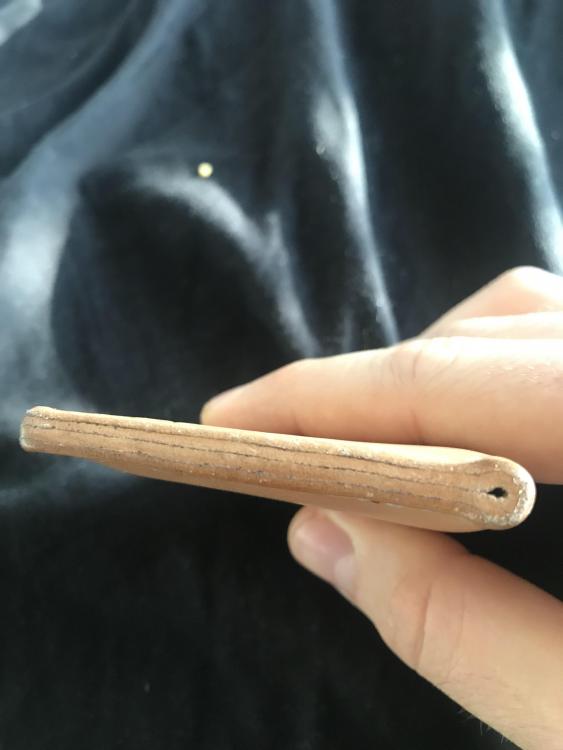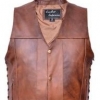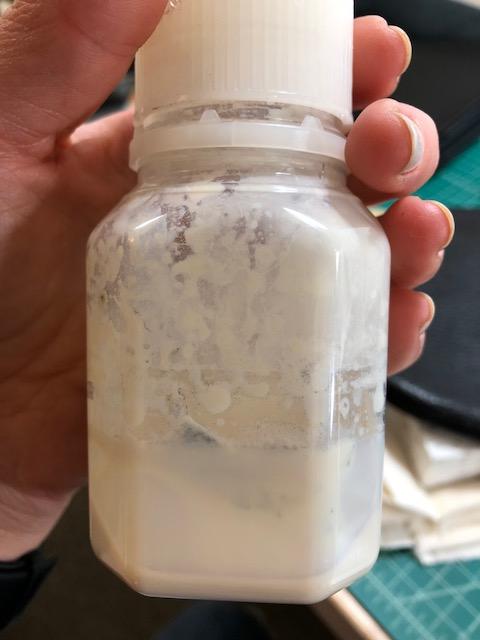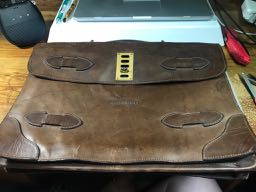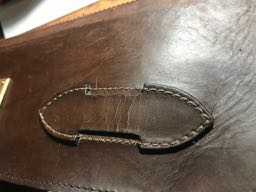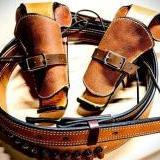Search the Community
Showing results for tags 'glue'.
-
I'm making a four sole sandal, three layers are leather, glued and stitched together. The fourth layer is 1/8" gum rubber, a full sole. What's the best glue for this? In my glue drawer I have Barge, Renia Top-Fit, Renia Aquilim 315, and Intercom Ecostick 1816B. The last one listed holds great when dry but the leathers separate when wet. They can be pulled apart. The shop is in my living room so i haven't done that experiment of soaking and pulling apart with the other glues. I'm thinking the water based glues will also not hold when the leather is well soaked but that possibly the barge will hold. Anyone know? The leather will be well roughed and the rubber, too. I have a one ton manual press for some pressure on it.
- 22 replies
-
- rubber to leather
- glue
-
(and 1 more)
Tagged with:
-
What are your opinions on barge cement consistency? Do you have a ratio of cement to thinner? When mine begins to get too thick to brush on comfortably (like thick honey), I add barge thinner by eye and mix, but sometimes it gets goopy. What would you compare your preferred consistency to? Honey, syrup, motor oil?
-
Hi there! I'm new here. I ran into a deal for a few varieties of good quality leather I wanted to use for the bottom and sides of a game board and other projects - the hitch? I'm completely new to leatherwork & using leather. I need some help to do this project right. The side of the board isn't thicker than half an inch with rounded edges, so I was thinking glue could solely handle the job if I wrapped leather around the bottom and sides. I'd like to avoid nails / staples. What brand of glue do I use and how do I apply it (Further information below)? Any other advice is appreciated also! The board is: Solid walnut. Straight grain. The leather is: Mostly very flexible (Few exceptions). Top Grain (Some full grain mixed in) 0.8-1.2mm thick Treated on the front facing side (Not the flesh side.) The board will be manipulated by people's hands regularly, but never bent or flexed. so I'd like it to be durable but feel good as well. The sides will be visible, the bottom will be occasionally seen. The environment this board would be kept in is going to be very humid, hot, and only rarely cool. If you want more information on the leather.. I have a decent variety of types. Most are stain protected (Some more some less.). The finishes vary from simply hand finished, burnished & waxed / cracked, gentle and rough sanded, just waxed, and matte. Any and all help is appreciated. Thanks!
-
Is anyone else having trouble finding contact cement? Home Depot and Lowes are about out, did a supply company burn down? DO NOT BLAME PUTIN, he saved the world from the Deep States next virus release
-
What is the best glue out there? Im wanting something that is really secure, permanent, and that will last forever. Any suggestions?
- 10 replies
-
- glue
- leathercraft
-
(and 1 more)
Tagged with:
-
Michael, Valerie, 1993, The Leatherworking Handbook: Cassell Illustrated, 128 p. This seems to be a very good general book on leatherworking, but it does not deal with carving and embossing. It can be found new or used through Bookfinder.com. Michael recommends PVA glue instead of contact cement. She says, "The most versatile adhesive is leatherworking grade PVA adhesive. It is used to hold gussets and pattern pieces in position ready for stitching, to secure turned edges, and to attach linings and reinforcements....Rubber solution is a contact adhesive. It is ideal for holding edges together while you are box stitching and for turning edges of lined belts and bags." Her directions for using PVA are about the same as contact adhesive. Apply the PVA to both surfaces. Let it dry until it begins turning from white to clear, at which point it will be tacky. Adhere the surfaces and press them together firmly. I never see PVA recommended by American leatherworkers. My question is whether it is okay to use PVA in place of contact cement? PVA remains flexible when dry. Using it would save exposure to hazardous chemicals. PVA is not waterproof and should not be used for leather swimsuits or leather life jackets, but most leather goods do not get a lot of exposure to water. I would appreciate reading some discussion of this from other leatherworkers.
-
I am wanting to make some leather nametags to put on the lockers at work. However, I tried using the pro-mag sheets from Michaels and some barge contact cement to glue them to the backs of my leather. They hold up ok for the first couple days, then they fall off, and they are hardly sticky anymore. I'm looking for a recommendation for a magnet strip, sheet, or glue i can use to make these work.
-
So I use Barge cement to glue up my leather pieces. The glue works great, the problem is when I then go to finish the edge, you can always see the little lines of glue rather than just a perfectly smooth edge. Usually what I do is glue up the pieces, then trim to size, sand the edge, then burnish with tokonole using a wooden edge slick. No matter how much i sand you can always see the lines. I see other people's work with utterly glass-like edges where they obviously were glued together. Is it because of the type of glue I'm using? Any advice would be appreciated.
- 10 replies
-
Hello everyone, I've been trying a number of leather glues recently and my favourite so far is Ecostick 1816B: it dries quickly, clear, and strong, without the odor of the solvent-based glues. I find it easier to use than Barge cement (and no fumes). That being said, I'm struggling to find a decent glue for gluing a zipper (fabric) to leather. What do you guys normally use? The catch is that the zipper is being as the closure for a zipper stationery case, so I need to be able to glue both sides of the zipper to two different leather pieces. For reference, the zipper stationery case is of this style: https://www.etsy.com/ca/listing/559862096/leather-zippered-5-slot-pen-case-leather Thanks in advance.
-
Hello all, I have been doing leather work for a few years now and I do it out of my apartment. I have tried many different adhesives on my work and ended up preferring barge glue over them all. I do large amounts of glueing, as I glue liners on all my work. The trouble is that barge glue stinks up the entire apartment even when doing it next to an open window and forces my wife and son to breathe the toxic fumes as well. I have considered buying a respirator, which would protect me but not my family, so that's out. I have also considered a vent hose the sucks the fumes through a window to the outside, which seems like the best option. My concern is that barge is flammable. From the reading I have done, it has been recommended that 'spark resistant' or 'explosion proof' fans be used when venting flammable vapors... But they cost and arm and a leg! I don't have that kind of money to spend but need a vent solution for the glues and dyes I use. If anyone has suggestions I'm all ears! Thank you for reading and God bless! -Dave-
-
Hi there, I am inexperienced when it comes to leather working. Following reading some books and some advice I have a few tools (which seem to be super expensive) and some bridle leather. The thickness of the leather makes it a bit unwieldy and I think the advice was not as good in this area. Having just bought a new computer, a 13" laptop, I would like to make a leather "skin" for it. I propose to cut the leather so its a few mm larger than the computer and simply stick it to the case. This will provide plenty of protection from scratches and bumps etc whist providing some much needed expression of individuality. The thing is I don't know what sort of glue / fixing to use. From using google most people say I need to scratch up the metal to make glue stick which I do not want to do. Also, at the end of its life I would like to take off the leather, clean it up and sell the computer on... My thoughts are that there are some very clever glues now a days. When a credit card arrives for example there seems to be some sort of silicon gel that works paper to plastic. With a prepared piece of leather to metal...? So, can anyone make any recommendations or is this simple the wrong approach for this? Kindest regards, Nicholas
-

Awl Sticks from glue in welt
MrLentz posted a topic in Gun Holsters, Rifle Slings and Knife Sheathes
Hi, I am making a knife sheath that is causing me some trouble and am wondering if anyone has a solution. I have the welt glued in with reina aquilim 315 which is a water based contact cement. It works great and I do follow the directions about applying to both sides, waiting until clear (around 30 min), then pushing pieces together and hammering. Then I waited at least 24 hours before using my awl and it seems as though the glue gets stuck to it creating little boogers. It makes it hell trying to punch the holes as well as slightly dangerous and prone to error when trying to hit the groove on the back side. I have been gluing the entire piece, so my next thought is I should try gluing everything except the area close to the approximate location of the stitch line. I think that would help, but on a welt - there really isn't much space there. I really don't want to resort to using Barges or the other hardcore cements, anyone else have this issue and have a solution for it? Thanks! -
Hi everyone, Hope your holidays are going well. I know that trying to iron on patches with glue backing on leather does not work well, as they don't stick. But what about suede leather? I have some ladies western style fringe suede vest. I also sell Native American style patches with very good iron on glue backing, not the cheap stuff that never sticks! I assume since suede leather is very "fuzzy" that glue would stick well to it, but I don't want to ruin a vest trying to find out. Anyone know if glue sticks a lot better to suede leather than normal leather? Thank you.
-
Hi all, It's been a long long time since I posted on here. I am currently experimenting with putting my embroidered patches that I sell onto leather purses and other small leather items. They have a very good solid heat glue backing. However that does not work well on leather. I did some searching and see that PETRONIO RUBBER CEMENT seems to be a good glue for leather. Is there anything better than that? I suppose I may have to rough up the solid glue backing on the patches to get them to stick. I tried the best glue that Tandy leather has and it did not work good at all. Any advice or tips much appreciated. Thank you.
-
I am making a heat shield for my motorcycle, I have my pieces cut out and dyed. After I got this far, I was like "Should I have glued my two layers of 4 oz veg tan leather before dying? When do I add the satin sheen?" I plan on gluing it down then stitching around the edge. I just want to make sure with my next project to do it in the correct order. TYSVM!
- 1 reply
-
- eco-flo satin sheen
- dye
-
(and 1 more)
Tagged with:
-
Could you suggest a shop that sells Aquilim 315 in Europe? Shipping cost can be sometimes higher than the actual product and I would like to have some options to choose form. Thanks, Georgia
-
Opened my water based glue (Saregum) and found mold on the walls of the container. The glue inside the bottle doesn't have visible mold. I am very apprehensive to use the glue and will probably throw it away. I've occasionally dipped (new, dry) q-tips directly into the jar of glue in application, and almost certainly, tiny pieces from the leather have gotten back into the jar. Wondering if anyone knows why the glue could have molded? Wouldn't have expected it to, but I'm not very familiar with water based glue yet. Also, would you agree that it's best to throw it out? Will pour from my main container into a per-use container next time so as to not contaminate the main jar of glue.
-
Hello everyone! I am fairly new at leather craft. To this point I have made a few pouches, belts, journals and delved into leather carving - but I've always used veg-tan fresh leather. I found a brief case at a thrift store yesterday (covered in dust and quite lonely). I really liked the style of it, and would like to modify it (smaller mainly) into a handbag. So in taking on this challenge, I've run into some conundrums as aspected haha. As I mentioned I've never worked on old leather, and this leather does appear quite thirsty. But also appeared to be a moderate quality bag as far as machine made goes. It doesn't appear to have a thick finishing layer, the moment I spritzed some water on the bag the leather soaked it up. Photos below (first 3 original bag, last 2 since desconstruction). My main two questions (at this point) are: 1) glue...ideas on removal? The bag was originally partitioned into 2 compartments, I'd like 1 larger compartment for the handbag. So I basically just need to get rid of 1 strip of old glue down the middle. 2) cracking... I'd like to bend the leather in 1/2 where the "<=>" shaped leather pieces are positioned. On first inspection of the leather in the area I plan to bend, I noticed some cracking :/ (prior to me attempting to bend). Any thoughts on how I can prep this leather to accommodate bending/minimize further cracking? Thank you so much for any advice you can lend me in this endeavor!
-
Hi Everyone, First post here. I am using Wickett and Craig harness leather for the first time. I am planning on using Master cement to glue my wallet together, both flesh to flesh and grain to flesh. I've heard applying two coats can make the bond stronger. Have y'all tried this? I have the refinished harness, so it is slick, oily and waxy...not great for gluing. Thanks for any help, guys.
-
I can't seem to find a previous post on using 3m spray adhesive on large flat areas of leather and fabric to be glued. Which 3m product is best the red or green can. Or is there a better product to use. I am wanting to glue liners in bags before sewing. Thanks
-
Ok I am brand new at this, I saw online where many people use rubber cement as a temporary binder to hold things still till it is sewn. I do not like the smell but I may be able to handle it Then comes the Barges in a blue tube. WOW no matter the ventilation if I smell it once I have a headache for an hour. Even after it dries for hours if I go near it I get a headache. What are good replacements for them that have much less smell? I was just using some Gorilla glue jell. I only used very little but I did not smell it at all! Will that be as good for a permanent option as the Barges? What can replace the rubber cement? Thanks Sled.
-
Just a heads up for those of you who use WeldWood Contact Cement gel, Lowe's has it on clearance. I believe that they are either getting rid of the old designed cans to possibly replace them with new ones OR moving away from carrying the 1 gallon cans. They do have the smaller cans of the gel, but the gallon cans are the better buy.
- 7 replies
-
- contact cement
- weldwood contact cement
- (and 9 more)
-
Is there a method (which I'm sure there is) to NOT get Barge cement on your fingertips when lining up belt edges? I hope I'm not divulging my naivete', but this is getting old. It's to the point that I wait to get a batch of belt orders so I don't have to spend EVERY day picking at Barge boogers off my hands.
-
I'm new to leatherwork. I'm looking for a glue I can use to stick leather pieces together so I can stitch them perfectly without all the parts moving around. Are there any glues I can use that can only stick temporarily And won't destroy my leather when I try to make my wallets. Thank you so much!
- 6 replies
-
- leather glue
- glue
-
(and 1 more)
Tagged with:
-
Hey all, new member and leather hobbyist here. This may be a very dumb question, but can I use super glue to bind edges of multiple layers of leather? I don't have a leather or saddle shop near me, so resources are limited to Hobby Lobby and online. Thanks, JC




